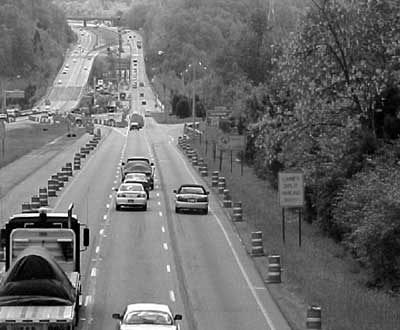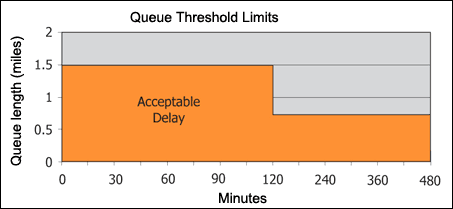Fact Sheet 8 - Ohio Keeps Motorists and Road Rehabilitation Moving Forward
Summer 2003
The Ohio Department of Transportation (ODOT) strives to maintain mobility while improving and rehabilitating its aging road network. To better meet the needs of motorists, ODOT has implemented a statewide policy to reduce traffic delay resulting from work zones. The ODOT Maintenance of Traffic (MOT) policy applies to all individuals who plan and perform work on interstate highways and freeways. It requires practitioners to coordinate construction activity with other ongoing projects, assess the potential impacts of work zones on the length of queues, and, above all, maintain adequate traffic flow during road rehabilitation.
Policy Requirements
The MOT policy requires each district to designate a District Work Zone Traffic Manager (DWZTM) to assist in the development of a Permitted Lane Closure Map (PLCM). The PLCM is a schedule of times lanes are permitted to be closed on interstates and other freeways in the district. Any project that will violate the PLCM lane closure times requires the district to perform an analysis of the project impact on traffic. If the analysis shows that expected queues violate the allowable queue thresholds of the policy the district must submit an exception request to the Maintenance of Traffic Exception Committee (MOTEC). Submitted with the exception request is a comparison of alternative work zone strategies, including but not limited to road-user costs, construction costs, construction schedule, and associated traffic queues for each alternative. The Multi-Lane Coordinator and any applicable Central Office specialty sections review the submitted work zone alternatives and provide recommendations to the MOTEC. The MOTEC will accept or deny the recommendations and can require further alternative recommendations or analysis from project personnel. The goal of the MOT policy and MOTEC review is to encourage project personnel and contractors to think creatively when considering and mitigating the impacts of work zones on congestion.
Queue Length Thresholds
Determining a project's impact on traffic includes analysis using various traffic impact simulation programs such as Quewz-92, Synchro/Simtraffic, Corsim, QuickZone, or similar programs. Multiple construction stages are analyzed separately if there are significant changes in the geometrics or operation of the work zone that could adversely affect traffic. Traffic volume data input into the models must be current and should account for seasonal traffic surges that may occur during construction. A vehicle is considered part of a queue if its average operating speed is approximately 10 mph or less.
Queue Threshold Limits:
Figure 1 — Maximum queue length thresholds for work zones with lane closures in Ohio
- Queues less than 3/4 mile are acceptable.
- Queues between 3/4 and 1 1/2 miles are acceptable for two hours
or less.
- Queues greater than 1 1/2 miles are not acceptable.
What Impact Is the MOT Policy Having?
"Today, motorist delays and the cost of congestion are one of the most critical elements in planning work zones."
—Bill Lozier, Deputy Director of Highway Management.
Source: ODOT News Release
Case Study 1: District One engineers are rehabilitating the Route 12 bridge that intersects with I-75 in Findlay, Ohio. The project scope includes demolishing and replacing the existing bridge over I-75 and reconstructing the interchange to allow for improved traffic flow. While taking steps to ensure the safety of the motoring public, mobility becomes an issue as well. To address safety issues, District One planned to divert traffic from I-75 over the ramps at the intersection of Route 12 for one weekend during demolition and again for a single weekend during erection of new steel girders. Directing traffic over the ramps allowed ODOT to avoid total closure of the interstate system and a lengthy detour route, which helped maintain mobility. Because the weekend lane closures were in violation of the permitted lane closure times, the MOTEC committee reviewed the Maintenance of Traffic alternatives and the proposed Traffic Management Plan (TMP). The MOTEC granted an exception to the permitted lane closure times and allowed the use of full lane closures on the mainline, while suggesting that the single lane ramps be split into two lanes using temporary traffic striping to enable greater traffic flow. The MOT policy ensured that consideration was given to mobility issues during the construction project. Project personnel cite minimal traffic disruption during the project as testament to the success of the MOT policy.
Case Study 2: An overpass on I-275 near Cincinnati required beam and deck replacement. During development of the scope for this project, ODOT analyzed the projected queues based on a plan to reduce the interstate from three to two lanes per direction and estimated that a 10-mile backup could occur. District 8, along with the Central Office, realized that such a delay would likely be unsafe and exceed MOT policy thresholds. District engineers decided to maintain three lanes of traffic in each direction by utilizing the outside shoulders in both travel directions, and crossing over one lane of traffic in the opposing direction to bypass the bridge work. Figure 2 shows how the crossover was used to maintain six lanes of traffic during the reconstruction of the bridge and how the use of concrete barriers was used to maintain a safe travel lane for opposing traffic. According to ODOT project personnel, the maintenance of traffic plan was very successful with no additional delay caused by the crossover, nor were there any serious injury crashes at this location during construction. Feedback from the general public on the maintenance of traffic through the work zone was also positive. ODOT continues to use the "contra flow" concept successfully on current projects.

Figure 2 — District 8 in Ohio crossed one lane of traffic onto the opposite side with barrier separation to maintain three lanes in each direction and avoid lengthy delays for motorists during construction
To learn more, contact:
Mack Braxton
Ohio Department of Transportation
Transportation Work Zone Specialist
Phone: 614-752-8829
Email: mack.braxton@dot.state.oh.us
Ken Linger
Ohio Department of Transportation
Transportation Work Zone Specialist
Phone: 614-466-0139
Email: ken.linger@odot.dot.ohio.gov
Tracy Scriba
Federal Highway Administration
Work Zone Mobility & Safety Team
Phone: 202-366-0855
Email: tracy.scriba@fhwa.dot.gov
U.S. Department of Transportation
Federal Highway Administration
Publication No. FHWA-OP-03-190

